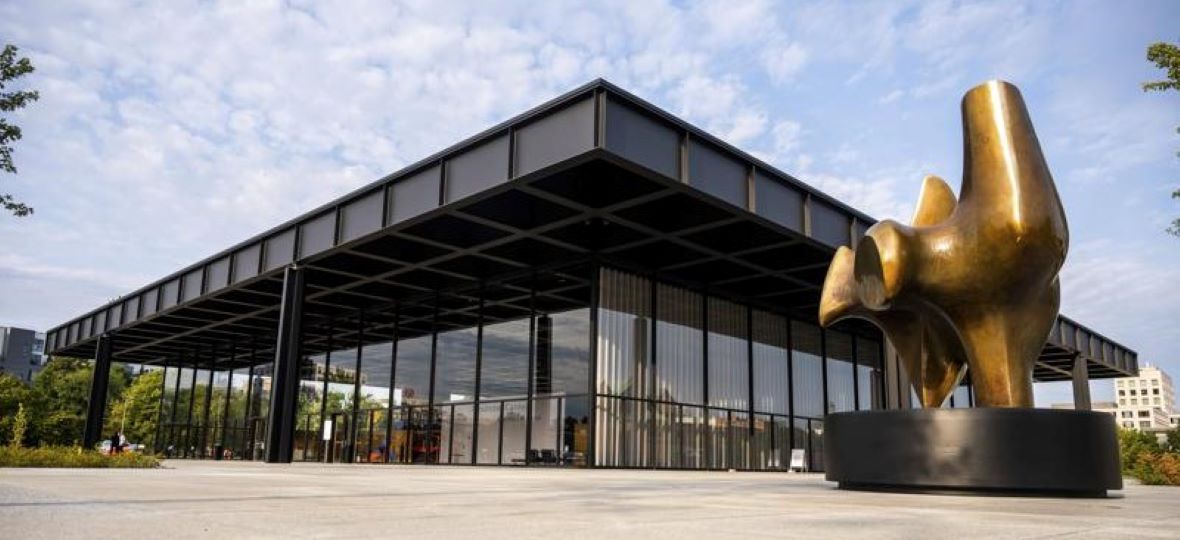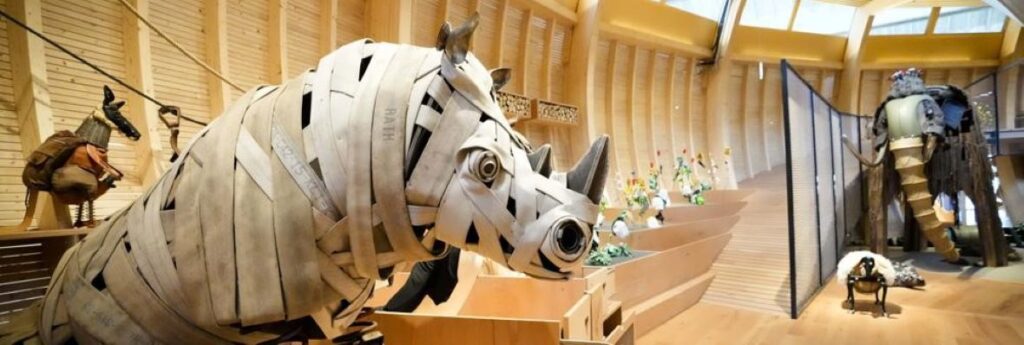Torrential rain pours down, waves break and big puddles splash as visitors enter the new children’s museum at the Jewish Museum in Berlin. No surprise there, because the exhibit is dedicated to the ancient story of Noah’s Ark and begins in the middle of the biblical deluge.
Young children are invited to actively participate in Noah’s journey as soon as they set foot in the newly opened ANOHA Children’s World. They can build little arks that they can float on a “deluge simulator” or help rescue 150 animals, created by over a dozen artists out of recycled material such as old spoons, espresso coffeemakers, pieces of carpet or bike fenders. They can even use the animals’ pretend excrement — represented by brown felt balls — to fertilize plants.
They can also cuddle a gigantic sloth, crawl through the serpentine body of an anaconda or take a rest on a yellow-eyed octopus.
The circular, wooden Ark is the centerpiece of the museum and spans 7 m.
tall and 28 m. wide. At its heart is an empty space where visitors are invited to sit down, linger, and think about life’s big universal questions: about God and the world, the past, and the future.
At the end of the tour, there are glimpses of the earth again, rocks lurking out of the retreating floods and a big rainbow on which kids can write their thoughts, wishes, or worries.
The ANOHA museum was built inside a former flower market, across the street from the Jewish Museum’s main building on a 2,700-sq.-m. space. It was meant to open in May 2020 but was delayed by the coronavirus pandemic.
While the main Jewish Museum’s permanent and temporary exhibitions primarily cater to adults and teenagers, the children’s museum targets the youngest visitors, children between three and 10.
“We tried to always listen to the children when we created this world,” Ane Kleine-Engel, head of the children’s museum, says. “From the beginning of the museum’s development, children were involved in the process and we plan to keep them on board as co-curators in the future as well.”
Beyond giving the kids ample space for play and creativity, the museum also tries to teach them about the importance of protecting the planet and biodiversity and fighting climate change.
“We want the children to start thinking about big themes, too, when they come here,” says Kleine-Engel. “When the animals get on board of the ark, they can’t choose who they like or dislike — everybody has to come along in order to survive – nobody should be excluded.”
The museum also educates children about equality and diversity and tries to make them understand that racism, anti-semitism and inequality should have no place on the Ark or in real life, Kleine-Engel adds.
And thus, in a very hands-on way, children can make sure that the cockroaches, rats and snakes also get a spot on Noah’s Ark. They can put them on the lap of a huge orangutan who will keep them from falling into the water.
In the end, all animals get a free ride on the Ark — as well as the children and their parents, who also get free entry into the museum.
Museum news
 Meanwhile, Berlin’s Neue Nationalgalerie, an iconic modern art museum designed by Bauhaus pioneer Ludwig Mies van der Rohe, (who was also the architect for Toronto’s Toronto Dominion Centre) reopened to the public this week after a six-year refurbishment of the glass-fronted building.
Meanwhile, Berlin’s Neue Nationalgalerie, an iconic modern art museum designed by Bauhaus pioneer Ludwig Mies van der Rohe, (who was also the architect for Toronto’s Toronto Dominion Centre) reopened to the public this week after a six-year refurbishment of the glass-fronted building.
Germany’s culture minister, Monika Gruetters, said during a celebration ceremony held Saturday that the occasion marked the museum’s “brilliant comeback as a pilgrimage site for lovers of modern art and as a stage for contemporary artists.”
British architect David Chipperfield oversaw the extensive refurbishment of the steel-and-glass structure, a project that cost 140 million euros ($207 million).
Mies van der Rohe was the last of three directors of the Bauhaus school of art and design, which started work in 1919 and was forced to shut down shortly after the Nazis came to power in 1933. He later emigrated to the United States.
The Neue Nationalgalerie was Mies van der Rohe’s only post-World War II building in Germany. It was built in then-West Berlin, not far from the Berlin Wall that divided the city for much of the Cold War. The museum opened in 1968, the year before the architect’s death.
Berlin Mayor Michael Mueller said that, shortly after the Wall was built, the building, with its transparent facade, stood for “progress, the avant-garde and modern, openness and internationality,” news agency dpa reported.
The museum is reopening with three exhibitions: a selection of key works from its collection, a show of works by sculptor Alexander Calder, and another dedicated to film and media artist Rosa Barbra.
Berlin is creating more space to show its contemporary art collection by building a new “Museum of the 20th Century” next door to the Neue Nationalgalerie.

